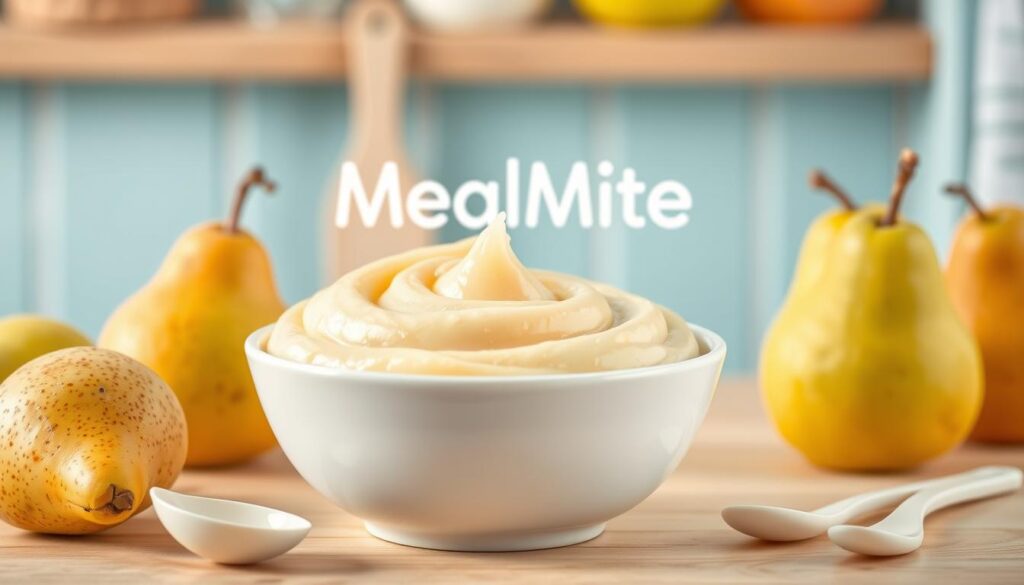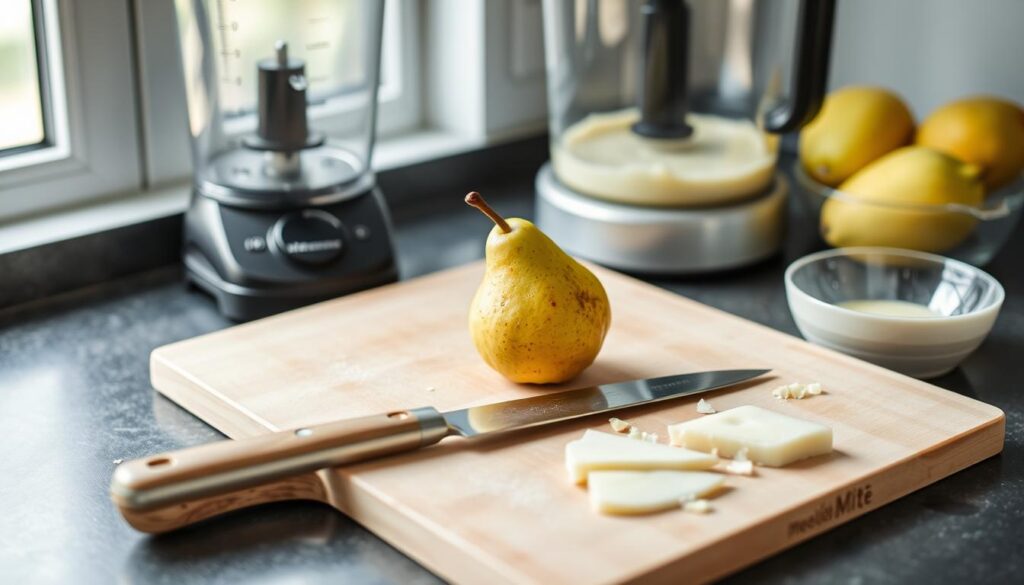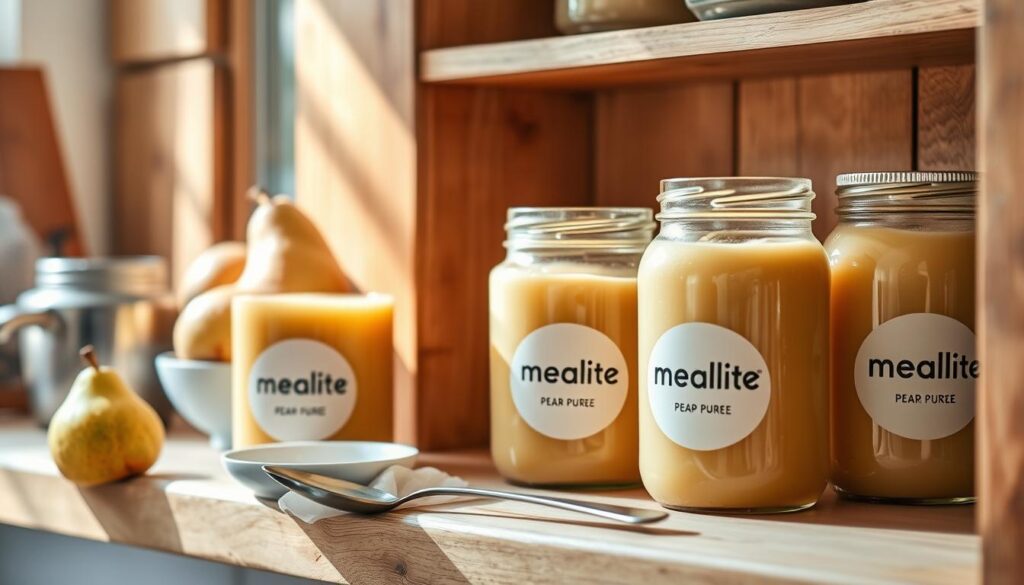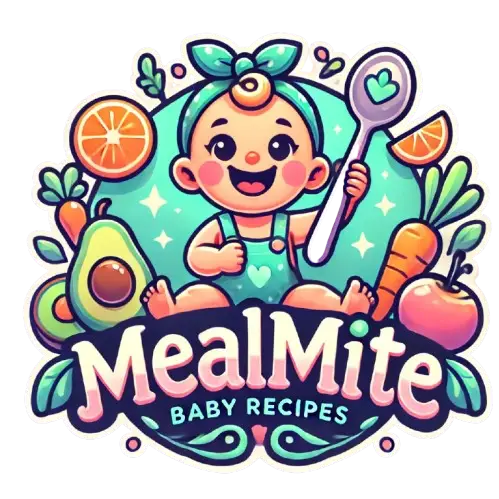Table of Contents
Ever thought about how to make an easy pear puree for a baby, healthy and tasty baby food without spending hours cooking? Making baby-friendly pear puree is surprisingly easy and great for your baby. It’s a simple recipe that ensures your baby eats the freshest, most natural foods.

With just a few steps and a few ingredients, you can make a nutritious, tasty meal for your infant. Curious yet? Let’s explore how to make pear puree and why it’s a great choice for your baby’s diet.
Key Takeaways
- Homemade baby food like pear puree is simple and quick to make.
- Pear puree offers numerous health benefits for your baby.
- Using fresh pears guarantees natural and wholesome meals for your little one.
- Introducing pear puree early helps familiarize your baby with new flavors.
- Learn the step-by-step process for preparing this baby-friendly pear puree at home.
Benefits of Pear Puree for Babies
Pear puree is packed with benefits for your baby, making it a great choice for their first foods.
Nutritional Benefits
Pear puree is full of vitamins and minerals like vitamin C, vitamin K, and copper. These are key for your baby’s immune system and health. Plus, pears have antioxidants that fight off cell damage.
Digestive Health
Pear puree is also high in fiber, which helps with digestion. This can prevent constipation, a common problem in young kids. Adding pear puree to your baby’s diet supports their digestive health during important growth stages.
Introducing New Flavors
Trying different flavors early on can help your baby enjoy new foods. Pear puree is sweet and mild, perfect for a first food. It not only tastes good but also encourages your baby to try more foods later.
Choosing the Right Pears
When making pear puree for your baby, picking the right pears is key. It affects the puree’s texture and taste. There are many types of pears, each with its own special qualities.
Types of Pears
The pear type you pick can change the puree’s flavor and feel. Here are some common ones:
| Pear Variety | Flavor Characteristics |
|---|---|
| Bartlett | Sweet and juicy |
| Comice | Delicate and buttery |
| Anjou | Mild and firm |
| Bosc | Crisp and slightly spicy |
These varieties can make a tasty organic pear puree for your baby. It depends on what you like in terms of sweetness and texture.
When to Buy Organic
It’s important to choose organic pears to keep your baby safe from pesticides. Organic pears are grown without harmful chemicals. This makes them a better choice for your child’s health.
If you’re new to making pear puree, buying organic is a good start. It ensures you’re using the best ingredients for your baby’s meals.
How to Make Pear Puree for a Baby
Making pear puree for your baby is easy and fast. You’ll need ripe pears, a fresh start for your little one’s diet. The key is to keep the fruit’s natural sweetness and nutrients.
- Choose ripe pears: Pick pears that are slightly soft to the touch. Varieties like Bartlett or Anjou are excellent choices.
- Peel and core: Remove the peel and core of the pears to eliminate seeds and tough parts.
- Cooking the pears: Steam or simmer the pears in water until they are tender. This usually takes about 10-15 minutes.
- Blending: Blend the cooked pears to a smooth consistency. Add water or breast milk to achieve the desired texture. Avoid adding sugar or preservatives.
- Storing: Store the pear puree in sterilized containers. It can be refrigerated for up to 3 days or frozen for longer storage.
By following these steps, you’ll master how to make pear puree effortlessly. It’s a cost-effective way to introduce your baby to solid foods, ensuring each feed is packed with natural goodness.
Essential Equipment for Making Pear Puree
Learning to make pear puree for your baby is easier with the right tools. This guide will show you what you need to make nutritious baby food easily.

- Steamer: Steaming pears keeps nutrients in and makes them soft. Use a good steamer basket or an electric steamer for quick results.
- Blender or Food Processor: A high-powered blender or food processor is key for smooth puree. Vitamix or Cuisinart are top choices for parents.
- Peeler: A sharp peeler is crucial for removing pear skin quickly, making the puree smooth.
- Cutting Board and Knife: You’ll need a sturdy cutting board and sharp knife to safely slice and core pears for steaming.
- Storage Containers: Use BPA-free containers to store your puree. OXO Tot or WeeSprout are great options.
Here’s a quick comparison of essential equipment:
| Equipment | Purpose | Recommended Brands |
|---|---|---|
| Steamer | Retains nutrients, softens pears | OXO, Hamilton Beach |
| Blender/Food Processor | Blends pears to desired consistency | Vitamix, Cuisinart |
| Peeler | Removes pear skin | Kuhn Rikon, OXO |
| Cutting Board and Knife | Prepares pears for steaming | John Boos, Wüsthof |
| Storage Containers | Stores finished puree | OXO Tot, WeeSprout |
Having these tools makes making pear puree easy for parents. Now, you’re ready to make healthy and tasty baby food!
Step-by-Step Guide to Making Pear Puree
Making a tasty and healthy baby puree starts with fresh, ripe pears. Here’s a detailed guide to help you make pear puree from scratch.
Cleaning and Peeling
Begin by washing the pears under cool water to get rid of dirt or pesticides. Use a vegetable brush for tough spots. Then, peel the pears with a vegetable peeler or a paring knife, making sure to remove all skin.
Cooking the Pears
After peeling and coring, cut the pears into small pieces. Put the pear chunks in a steamer basket over boiling water. Steam them for about 10 minutes until they’re soft. If you don’t have a steamer, boil the pear pieces in a little water at the same time.
Blending to Perfection
Put the cooked pears in a blender or food processor. Blend until it’s smooth and ready for babies. If it’s too thick, add a bit of cooking liquid or milk to get the right consistency.
| Ingredient | Steps |
|---|---|
| Pears | Clean, Peel |
| Cooking liquid or milk | Adjust consistency |
Storing Pear Puree
Keeping pear puree fresh and nutritious is key. Whether you store it in the fridge or freezer, follow these tips. This way, your baby will have safe and tasty meals.

Refrigeration Tips
For use within a few days, the fridge is best. Here’s how to store it right:
- Use airtight containers: Move the puree to clean, airtight containers. This stops contamination and keeps smells out.
- Label and date: Always mark the containers with the prep date. Pear puree stays good in the fridge for up to 48 hours.
- Keep it cool: Place containers on a shelf, not in the fridge door. The door’s temperature changes too much.
Freezing Pear Puree
Freezing is great for longer storage. Here’s how to freeze portions for later:
- Portion control: Freeze in ice cube trays for small portions. It’s easy to thaw just what you need.
- Store in freezer bags: Move the cubes to labeled and dated zip-lock freezer bags. This is a good way to store baby puree.
- Use within time: For the best taste, use frozen pear puree within three months.
These tips help keep homemade baby food fresh and safe. By refrigerating or freezing your pear puree correctly, you ensure your baby gets nutritious meals anytime.
Serving Ideas and Mix-ins
Adding pear puree to your baby’s meals can be both tasty and healthy. Mixing different ingredients not only makes food more flavorful but also more nutritious.
Combining with Other Fruits
Exploring what can I mix with pear puree for baby can introduce new and exciting tastes. Mixing pear puree with other fruits adds a variety of flavors and nutrients.
- Apple and Pear Puree: Apple and pear puree mix offers a sweet and slightly tart taste that babies enjoy.
- Banana and Pear Puree: Banana’s creamy texture pairs well with pear puree, creating a tasty blend.
- Peach and Pear Puree: Peach and pear puree mix is a fruity combination rich in vitamins.
Mixing with Grains
Adding grains to pear puree makes meals more nutritious. It adds essential fibers and nutrients. Here are some grain options:
- Oatmeal and Pear Puree: Mixing pear puree with oatmeal creates a nutritious and filling meal for your baby.
- Rice Cereal and Pear Puree: Rice cereal and pear puree mix offers a smooth and nutritious dish.
- Quinoa and Pear Puree: Quinoa and pear puree mix adds protein, making the meal more nutritious.
| Fruit or Grain | Benefits | Suggested Age |
|---|---|---|
| Apple | Rich in fiber and vitamins | 6 months+ |
| Banana | High in potassium and vitamins | 6 months+ |
| Peach | Loaded with vitamins A and C | 6 months+ |
| Oatmeal | Excellent source of fiber | 6 months+ |
| Rice Cereal | Gentle on the digestive system | 4 months+ |
| Quinoa | High in protein and essential amino acids | 8 months+ |
Frequently Asked Questions about Pear Puree
Parents often wonder about new foods for their babies, especially homemade baby food. We’ve got answers to common questions about pear puree and other baby food FAQs. This should help ease any worries you might have.
How Long Does Pear Puree Last?
Keeping your pear puree fresh and safe is key. In the fridge, it stays good for up to 3 days. Use an airtight container for storage. For longer, freeze it for up to 3 months. Always mark the containers with the date to know when it was made.
Can You Add Spices?
Adding new flavors can be fun for your baby. You can try mild spices like cinnamon or a bit of vanilla. But, start with just one spice at a time. Watch for any reactions. Avoid strong spices like pepper for now.
These FAQs are here to help you understand pear puree better. They also show how to make it more flavorful for your baby’s enjoyment.
Tips for Feeding Pear Puree to Your Baby
Introducing pear puree to your baby’s diet can be a delightful and nutritious experience. Here are some practical tips to help you along the way:
Portion Size: Start with small amounts. A teaspoon of pear puree is ideal for first-timers. Gradually increase the portion as your baby becomes more accustomed to the new flavor and texture.
Frequency: Initially, offer pear puree once a day to observe any potential allergic reactions or digestive issues. As your baby becomes more comfortable, you can increase the frequency to two or three times a week.
Readiness Signs: Ensure your baby shows signs of readiness for solids. Look for cues such as being able to sit up with support, showing interest in your food, and losing the tongue-thrust reflex.
“Introducing solids is a milestone. Consistency and patience are key. Observe your baby for any discomfort and adjust accordingly.”
Consistency: The texture of your pear puree should be smooth to avoid any choking hazards. You can add a little breast milk or formula to achieve a thinner consistency if needed.
Encouragement: Encourage your baby by eating with them. Babies often mimic their parents’ actions, and seeing you eat can make them more interested in trying new foods.
- Be Patient: Some days your baby may eat more, and other days less—this is perfectly normal when feeding baby puree.
- Timing: Choose a time when your baby is alert and not too hungry or tired to introduce new foods.
Remember, every baby is unique. Adjust your approach based on your baby’s preferences and readiness for pear puree. With these pear puree tips, you’ll be well on your way to creating enjoyable and smooth baby meals.
Conclusion
Making pear puree for baby meals is easy and nutritious. It’s a simple, healthy first food for your little one. It also adds variety to their diet.
Choosing the right pears and storing them well is key. Each step helps your baby start their food journey right.
Pear puree is more than just easy to make. It’s full of nutrients that help your baby grow and digest food well. It introduces new flavors and healthy eating habits.
Starting with homemade baby meals might seem hard. But making pear puree is simple and rewarding. It lets you give your baby nutritious, tasty meals.
Try making your own pear puree. It will bring joy to your baby’s meals. Your effort in making healthy meals will benefit their health and happiness.
FAQ
How long does pear puree last?
You can keep homemade pear puree in the fridge for up to 3 days. For longer storage, freeze it for up to 3 months. Always use airtight containers to keep it fresh.
Can you add spices to pear puree?
Yes, you can add spices like cinnamon or nutmeg to pear puree. But start with small amounts and check with your pediatrician first. This ensures your baby can handle these flavors.
What types of pears are best for making puree?
Bartlett, Anjou, and Bosc pears are great for puree. They’re sweet and soft, making them easy to blend into a smooth puree.
When should I buy organic pears?
Buy organic pears to reduce pesticide exposure for your baby. This is crucial for babies with developing immune systems. You can find organic pears at most grocery stores and farmers’ markets.
How do I introduce new flavors to my baby using pear puree?
Mix pear puree with other fruits like apple or peach for new tastes. Adding grains like oatmeal or rice cereal can make meals balanced and tasty for your baby.
What equipment do I need to make pear puree?
You’ll need a steamer or pot for cooking, a blender or food processor for blending, and containers for storing. This is for refrigerating or freezing the puree.
Can I mix pear puree with other baby foods?
Yes, you can mix pear puree with baby-friendly foods like yogurt, rice cereal, or other fruit and vegetable purees. This adds variety and boosts nutritional value.
How do I store pear puree?
Store pear puree in airtight containers. For up to 3 days, keep it in the fridge. For longer, freeze it in single portions for up to 3 months. Thaw frozen puree in the fridge overnight before using.
What are the benefits of pear puree for infants?
Pear puree is full of vitamins and minerals. It supports digestion with its fiber and introduces new flavors. It’s a soft, sweet option for infants.
How do I know when my baby is ready for pear puree?
Babies are usually ready for pear puree around 6 months. Look for signs like sitting up, showing interest in food, and having good head control. Always check with your pediatrician if unsure.

1 thought on “Pear Puree for A Baby: 3 Tips to Make Easy Meals (Stress-Free)”